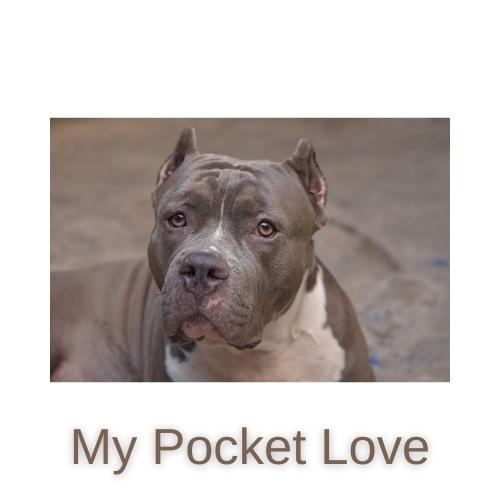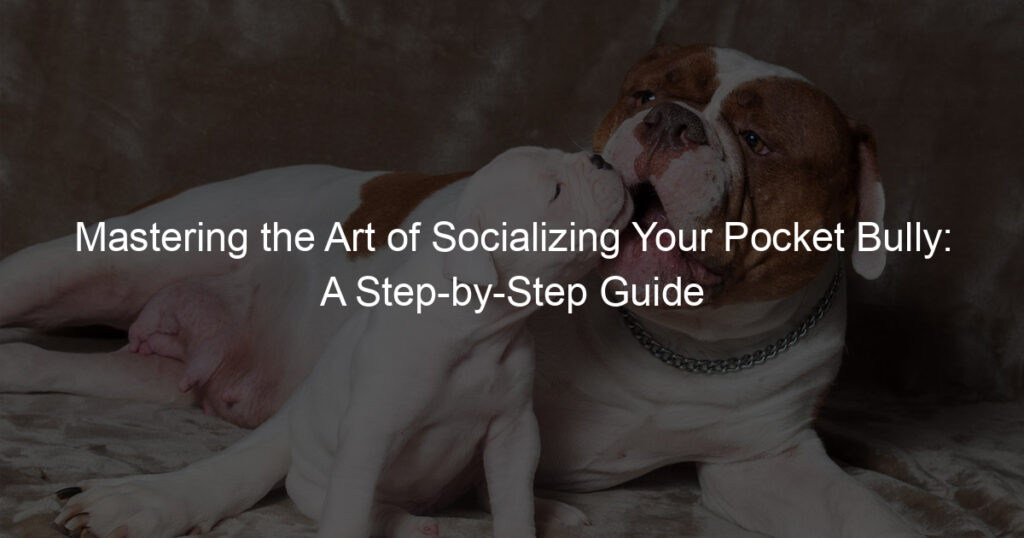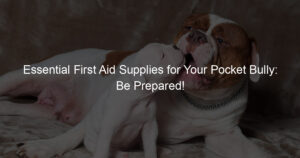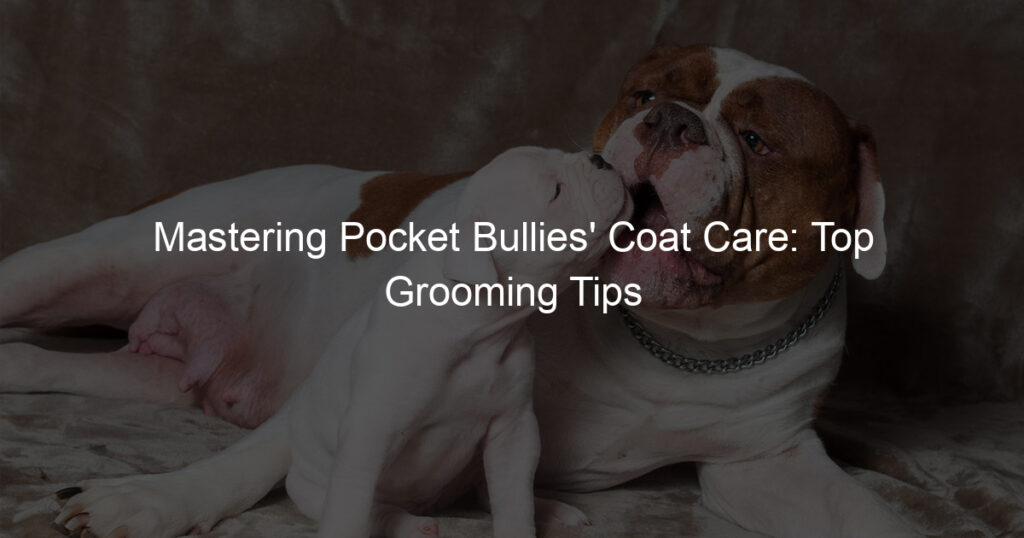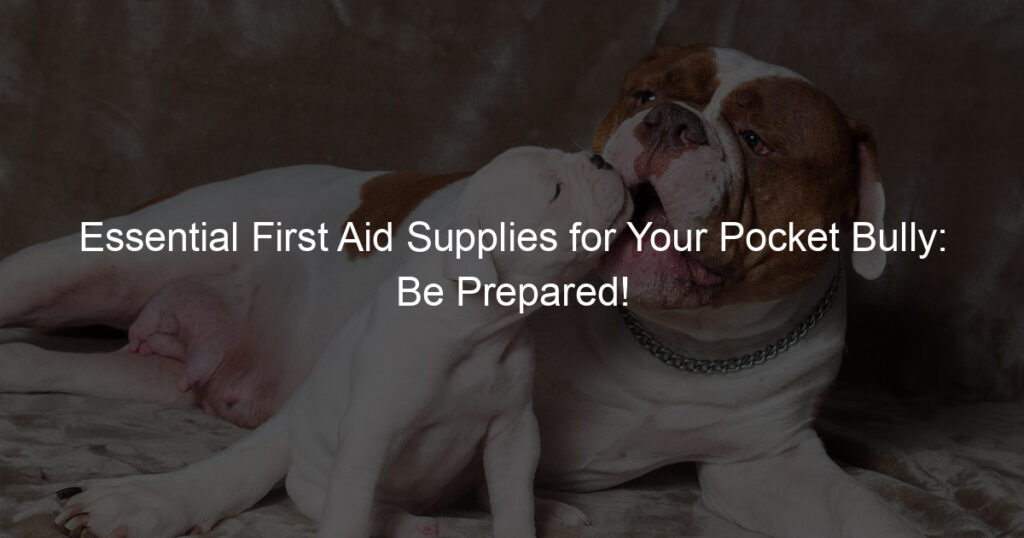
Introduction to Pocket Bullies
Welcome to our comprehensive guide on Pocket Bullies, a unique and fascinating breed of dogs. In this post, we will delve into understanding the breed, their characteristics, and the importance of socialization for Pocket Bullies.
- Understanding the breed
- Characteristics of Pocket Bullies
- Importance of socialization for Pocket Bullies
The Pocket Bully is a smaller type of the American Bully, a breed that originated in the 1980s and is known for its friendly temperament and muscular, robust appearance. Despite their intimidating look, Pocket Bullies are known for their affectionate and loyal nature. They are called ‘pocket’ because they are compact and can fit into ‘your pocket’, metaphorically speaking.
Pocket Bullies are distinguished by their compact size, muscular build, and wide-set, short legs. They have a broad chest and a large, blocky head. Despite their tough exterior, they are gentle and friendly dogs, making them excellent companions. They are intelligent, eager to please, and trainable. However, they require a lot of exercises to keep them healthy and happy.
| Height | Weight | Lifespan |
|---|---|---|
| 12-16 inches | 30-50 pounds | 11-13 years |
Socialization is crucial for all dogs, and Pocket Bullies are no exception. It helps them to become well-rounded and well-behaved dogs. Socialization exposes them to various people, environments, and other animals, helping them to react appropriately in different situations. Without proper socialization, Pocket Bullies can become fearful or aggressive. Therefore, it’s essential to start socializing them from a young age.
Stay tuned as we delve deeper into the importance of socializing Pocket Bullies, steps to socialize them, and training for socialization in the following sections.
Understanding the Importance of Socializing Pocket Bullies
When it comes to raising a happy and healthy Pocket Bully, one of the most important aspects to consider is socialization. This process involves introducing your Pocket Bully to a variety of experiences, including different environments, people, and other animals. Let’s delve deeper into the importance of socializing Pocket Bullies.
- Benefits of Socialization
- Impact on Pocket Bullies Behavior
- Role in Developing Pocket Bullies Social Skills
Socializing your Pocket Bully has numerous benefits. It helps your pet become more comfortable in different situations, reducing their stress and anxiety. Socialization also helps prevent behavioral problems, as your Pocket Bully learns how to interact appropriately with others. Furthermore, it can improve your pet’s overall happiness and well-being, as they get to explore and experience the world around them.
Socialization has a significant impact on a Pocket Bully’s behavior. Without proper socialization, Pocket Bullies may become fearful or aggressive in unfamiliar situations. On the other hand, a well-socialized Pocket Bully is likely to be more confident, calm, and friendly. They are less likely to react negatively to new experiences and are generally more adaptable and easier to train.
Socialization plays a crucial role in developing a Pocket Bully’s social skills. Through socialization, they learn how to communicate and interact with other animals and people. They learn to understand and respond to social cues, which is essential for their ability to get along with others. This not only makes them more pleasant to be around but also contributes to their overall mental health.
In conclusion, socializing your Pocket Bully is an essential part of their upbringing. It not only benefits their behavior and social skills but also contributes significantly to their overall happiness and well-being. So, make sure to invest time and effort into properly socializing your Pocket Bully.
Steps to Socialize Pocket Bullies
Training your Pocket Bullies to be sociable is an essential part of their development. Here are five simple steps to help you socialize your Pocket Bullies effectively:
- Start Early
It’s crucial to start socializing your Pocket Bullies as early as possible. Puppies are most receptive to new experiences between 3 and 12 weeks old. During this period, they can learn to feel comfortable around different people, environments, and other animals.
- Expose to Different Environments
Take your Pocket Bullies to various places such as parks, pet stores, and busy streets. This exposure will help them adapt to different sounds, sights, and smells, making them less likely to be fearful or aggressive in unfamiliar situations.
- Introduce to Various People and Animals
Introduce your Pocket Bullies to a wide range of people, including children, elderly people, and people in uniforms. Also, let them meet other animals. This will help them understand that different types of people and animals are not threatening.
- Encourage Positive Interactions
Always ensure that your Pocket Bullies’ interactions with people and other animals are positive. Use treats and praises to reward your dog for behaving well. This will encourage them to repeat the good behavior.
- Reinforce Good Behavior
Consistently reinforce your Pocket Bullies’ good behavior with rewards. This could be a treat, a favorite toy, or praise. This reinforcement will make them more likely to repeat the good behavior in the future.
Remember, socializing your Pocket Bullies is a gradual process that requires patience and consistency. But with time and effort, your Pocket Bullies can become well-adjusted and sociable pets.
Pocket Bullies Training for Socialization
Training your Pocket Bullies for socialization is a crucial step in raising a well-behaved, friendly, and confident dog. Let’s explore some effective training techniques that can help you in this process.
Training Techniques
Here are some proven techniques that can aid you in training your Pocket Bullies for socialization:
-
Positive Reinforcement
Positive reinforcement involves rewarding your dog for good behavior. This can be done through treats, praise, or extra playtime. For instance, if your Pocket Bully behaves well around other dogs, reward them with a treat. This will encourage them to repeat the behavior. Remember, consistency is key in this method.
-
Clicker Training
Clicker training is another effective technique. It involves using a clicker, a device that makes a distinct sound, to signal to your dog that they have done something right. The clicker sound is followed by a reward, which helps your dog associate the sound with positive behavior. For example, if your Pocket Bully sits when told to, you can click the clicker and give them a treat.
-
Professional Training Classes
Professional training classes can also be beneficial. These classes are led by experienced trainers who can provide guidance and help address any specific issues you may be facing. They also provide a great opportunity for your Pocket Bully to interact with other dogs, which can boost their socialization skills.
Remember, every dog is unique and what works for one might not work for another. It’s important to be patient and consistent in your training efforts. With time and practice, your Pocket Bully will learn to be more social and comfortable around others.
Training Challenges
Training a Pocket Bully for socialization is not without its challenges. However, with patience, consistency, and the right techniques, these hurdles can be overcome. Let’s explore some of the common challenges and how to address them.
- Overcoming fear and anxiety
Fear and anxiety can be a significant barrier in the training process. Pocket Bullies, like any other dogs, can sometimes be fearful or anxious in new situations. This fear can manifest in various ways, such as hiding, shaking, or even aggression.
To help your Pocket Bully overcome fear and anxiety, it’s crucial to expose them gradually to new experiences, people, and other animals. This gradual exposure, known as desensitization, can help them become more comfortable and confident. Remember, it’s essential to keep these experiences positive to avoid reinforcing fear or anxiety.
- Dealing with aggression
Aggression can be another challenge when training Pocket Bullies. This behavior can stem from fear, frustration, or a lack of socialization. It’s important to understand that aggression is often a response to a perceived threat.
Addressing aggression involves identifying the triggers and working to desensitize the dog to these triggers. It’s also crucial to reinforce positive behavior and provide plenty of exercise to help manage energy levels and reduce frustration. If aggression continues, seeking professional help from a dog trainer or behaviorist may be necessary.
- Addressing stubbornness
Stubbornness can make training more challenging. Pocket Bullies are known for their strong will, and sometimes, they may seem resistant to training.
Overcoming stubbornness involves being consistent and patient. It’s important to establish clear rules and stick to them. Using positive reinforcement techniques, like treats or praise, can also be effective. Remember, training should be a positive experience for your Pocket Bully, so keep sessions short, fun, and rewarding.
In conclusion, training a Pocket Bully for socialization can be challenging, but it’s not impossible. With the right approach, patience, and consistency, you can help your Pocket Bully overcome these challenges and become a well-socialized, confident, and happy dog.
Proper Socialization for Pocket Bullies: Case Studies
Let’s delve into some real-life scenarios to better understand the process and importance of properly socializing Pocket Bullies. These case studies will provide practical insights into the challenges and successes of socializing these dogs.
-
Case Study 1: Successful Socialization
Meet Max, a charming Pocket Bully who was successfully socialized from a young age. Max’s owner, Sarah, understood the importance of socialization and started the process when Max was just eight weeks old. She introduced him to a variety of environments, people, and other animals.
Max was taken to dog parks, busy streets, and even to Sarah’s office. He was introduced to people of different ages, sizes, and ethnicities. He also met other dogs, cats, and even a few farm animals. Sarah made sure that all these experiences were positive for Max, rewarding him with treats and praises.
Today, Max is a well-adjusted adult Pocket Bully. He is friendly, confident, and shows no signs of aggression or fear in new situations. This case study shows that with consistent effort and patience, successful socialization is achievable.
-
Case Study 2: Overcoming Socialization Challenges
Now, let’s look at Bella, a Pocket Bully who had a challenging start. Bella was adopted from a shelter at six months old, and she had not been properly socialized. She was fearful of people and other animals, and she would often react with aggression.
Bella’s new owner, John, faced many challenges in socializing her. He had to start slowly, first introducing her to quiet environments and only a few people at a time. He used positive reinforcement, rewarding Bella with treats and praises whenever she reacted calmly to a new situation.
It took time and patience, but Bella gradually became more comfortable with new experiences. Today, she is much more confident and less reactive. Bella’s story shows that even with a challenging start, it is possible to overcome socialization issues with consistent effort and patience.
These case studies highlight the importance of early and consistent socialization for Pocket Bullies. They also show that it’s never too late to start the process. With patience, consistency, and positive reinforcement, you can help your Pocket Bully become a well-adjusted and confident dog.
Key Takeaways: Pocket Bullies Socialization Process
As we conclude our exploration of the socialization process for Pocket Bullies, let’s reflect on the key points we’ve discussed. These takeaways will serve as a guide for you to ensure your Pocket Bully grows into a well-behaved and sociable pet.
- Importance of early and consistent socialization:
Starting the socialization process early is crucial for Pocket Bullies. The first few months of a puppy’s life are a formative period when they are most receptive to learning and adapting to new experiences. Consistent socialization throughout their life helps to reinforce positive behaviors and habits. Remember, socialization is not a one-time event but a lifelong process.
- Role of positive interactions in socialization:
Positive interactions play a significant role in the socialization process. These interactions, whether with humans or other animals, help Pocket Bullies to develop confidence and reduce fear and anxiety. Always ensure that your Pocket Bully’s interactions are positive and rewarding.
- Benefits of professional training:
Professional training can be a valuable tool in the socialization process. Trainers have the knowledge and experience to guide your Pocket Bully through different social situations, teaching them appropriate behavior. They can also provide you with tips and techniques to continue the training at home.
- Impact of socialization on Pocket Bullies behavior and social skills:
Socialization has a profound impact on a Pocket Bully’s behavior and social skills. A well-socialized Pocket Bully is more likely to be confident, friendly, and less likely to exhibit aggressive or fearful behavior. They are also more comfortable in various social situations, making them a joy to be around.
In conclusion, the socialization process for Pocket Bullies is a vital part of their development. It requires time, patience, and consistency, but the rewards are well worth the effort. A well-socialized Pocket Bully is a happy, confident, and well-adjusted pet that will bring joy to your life.
